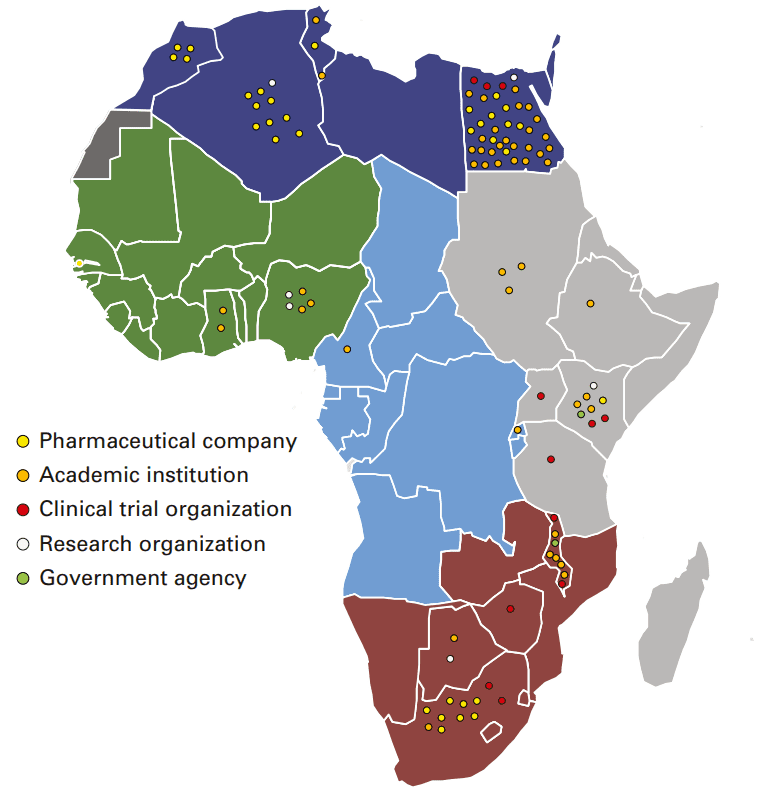Ongoing cancer clinical trials in Africa in 2020 From Unger J.M. et al. JNCI J Natl Cancer Inst 2019. * Circles represent individual clinical trials * Colors of the circles represent the study’s primary sponsor type
The cancer clinical trials context
Clinical trials (CTs) are critical for advancing cancer research and developing new treatments that improve patient outcomes. Patient participation forms the foundation of these trials, facilitating the rapid and efficient evaluation of potential therapies. By increasing participation rates, researchers can expedite the discovery of innovative treatments, benefiting the broader cancer patient population. Moreover, CTs offer patients access to cutting-edge therapies, underscoring the importance of equitable and accessible trial opportunities for all.
In the United States, cancer ranks as the second leading cause of death following heart disease [National Centre for Health Statistics, 2017]. This trend extends beyond affluent nations, affecting diverse populations worldwide. For instance, individuals of African descent, particularly those living on the continent, experience disproportionate rates of certain cancers. Compared to their counterparts in the US, incidence rates of Kaposi’s sarcoma are ten times higher, cervical cancer rates are four times higher, and liver cancer rates are significantly elevated at 24% higher. Additionally, triple-negative breast cancer affect women of African descent at higher rates, while prostate cancer outcomes are notably poorer among men of the same ethnic background. The disparity in cancer mortality rates before the age of 75 between Africa and high-development index countries (nearly doubled rates) further underscores the urgency of addressing these disparities.
These disparities stem from a complex interplay of factors, including inadequate healthcare infrastructure in Africa and unique tumour genetic and biological characteristics among populations of African descent. Therefore, achieving diversity in CTs participation is crucial to ensuring that new cancer treatments are effective and safe across all patient populations.
Despite the importance of inclusive participation, CTs face significant challenges in recruiting patients from diverse racial and ethnic backgrounds. Disparities persist, particularly between Caucasians and other ethnic groups, highlighting the need for targeted strategies to enhance participation rates among underrepresented populations.
Cancer CT participation rates
Participation rates in cancer CTs reveal significant insights into patient engagement with innovative treatments. Approximately 20% of cancer patients meet the criteria for CT eligibility, yet only 15–25% of these eligible patients actually participate in such trials. Consequently, a mere 3–5% of cancer patients in the United States are enrolled in CTs [National Cancer Institute; American Society of Clinical Oncology, 2010].
Moreover, disparities in CTs participation among demographic groups are evident. Age plays a crucial role, with participation declining significantly among older individuals. For instance, compared to those aged between 30–64, patients aged 65–74 are only 0.43 times as likely to participate, while those aged 75 and older are even less likely at 0.15 times. Gender also influences participation rates, with men being 1.2–1.8 times more likely than women to take part in cancer CTs. Furthermore, compared to Caucasians, African Americans (AAs) and Hispanics show lower participation rates, approximately 0.7 times as likely as Caucasians. This underrepresentation is underscored by statistics from 2018, where the US Food and Drug Administration estimated that only 4% of participants in CTs leading to new cancer drug approvals were of African descent.
The disparity between patient willingness to participate in trials and actual participation rates highlights numerous barriers within the system. Identifying and addressing these barriers are critical research objectives for cancer investigators, aimed at enhancing inclusivity and accessibility in clinical research initiatives.
Barriers to participation in cancer CT
More than half (55.6%) of all American cancer patients are unable to participate in cancer CTs due to the absence of trials suited to their specific cancer type and stage at their treatment centre. Even when trials are available, an additional 21.5% of patients are deemed ineligible. These exclusions stem from stringent eligibility criteria designed to ensure patient safety and maintain homogeneity within study cohorts, which can inadvertently limit the inclusion of diverse patient populations.
As a result, structural and clinical factors contribute to a substantial proportion – 77.1% – of US patients not participating in CTs. The expanding approach of biomarker-specific eligibility criteria to tumour staging may further restrict access for certain patients. However, there is optimism surrounding the emergence of precision medicine-oriented umbrella trials, which aim to broaden access by allowing treatment across various biomarker profiles.
Physician and patient factors also influence non-enrollment in CTs. Physicians may refrain from discussing trial options due to time constraints, reimbursement issues, or personal treatment preferences. This missed opportunity is critical, as studies show that eligible patients often accept trial participation when recommended by their doctors more than 50% of the time.
Patients themselves may decline participation due to a variety of reasons, including a desire to maintain autonomy in treatment decisions, concerns about potential side effects, emotional distress, financial and insurance worries, communication challenges with medical staff, and logistical hurdles such as transportation difficulties.
Compared to other groups, AAs report more misperceptions and concerns about research, which may be attributable to historical research mistreatment.
A few data on barriers in CTs participation for African women
Insights into barriers to participation in CTs among African women underscore significant challenges in the region, particularly in East Africa, which has the world’s highest incidence and mortality rates of cervical cancer. In 2018, East Africa reported an estimated age-adjusted mortality rate of 16 per 100,000, compared to just 1 per 100,000 in North America.
A cervical cancer prevention programme in Kenya focused on screening women positive for high-risk human papillomavirus (hrHPV), encountered barriers at various stages of the treatment process. As hrHPV testing is relatively new in low- and middle-income countries, there is limited data on barriers to women’s completion of a cervical cancer prevention cascade after screening. Barriers may arise at stages such as decision-making about treatment, navigating the treatment process, and receiving treatment.
Similar challenges have been documented in other sub-Saharan African countries like Tanzania, Botswana, and Uganda. Key obstacles included limited understanding of HPV and cervical cancer among women, alongside significant logistical challenges such as transportation costs and accessibility to treatment facilities, all crucial factors to consider given the average daily wage for a Kenyan agricultural worker. Beyond the financial aspects, issues at treatment sites were also identified as potential barriers, including long wait times, supply shortages, unavailability of screening results, and inadequate space and staffing, further hindering women’s access to timely care.
Conversely, several facilitating factors were identified that encouraged women to seek treatment, such as having fewer dependents under age 13, higher educational attainment, participation in Community Health Campaigns (CHC) in replacement of work, endorsement by influential figures, and a proactive intention to seek treatment upon testing positive for hrHPV.
Addressing these barriers and enhancing supportive factors are critical steps toward improving the accessibility and effectiveness of cervical cancer prevention and treatment initiatives across Africa. Efforts focusing on education, infrastructure improvement, and community engagement are vital in overcoming these challenges and reducing the burden of cervical cancer in the region.
Conclusion
These findings underscore the critical need to address both structural and clinical barriers that prevent more than three-quarters of cancer patients from participating in CTs. Furthermore, research suggests that African Americans (AAs) and Caucasians are equally likely to participate in trials when presented with equitable opportunities, challenging existing disparities in research participation.
To improve recruitment and retention in CTs, strategies recommended by the National Cancer Institute (NCI) and the American Society of Clinical Oncology (ASCO) emphasise providing personalised support to overcome educational, communication, and logistical obstacles to treatment and follow-up care.
With Africa projected to experience a doubling of its cancer mortality rate by 2040, expanding the conduct of cancer clinical trials across the continent is crucial. This expansion is essential for ensuring comprehensive evaluations of new cancer treatments across diverse African ethnicities.
Veronique Ropion, MD
Strategic Projects Director, Pharmalys
References:
- Cartmell KB. Et al. Patient barriers to cancer clinical trial participation and navigator activities to assist. Adv Cancer Res. 2020 ; 146: 139–166. doi:10.1016/bs.acr.2020.01.008
- Graef K.M. et al. Operational Strategies for Clinical Trials in Africa. JCO Global Oncol 2020; 6:973-981.
- Page CM, Ibrahim S, Park LP, Huchko MJ (2019) Patient factors affecting successful linkage to treatment in a cervical cancer prevention program in Kenya: A prospective cohort study. PLoS ONE 14(9): e0222750. https://doi.org/ 10.1371/journal.pone.0222750
- Page CM, Ibrahim S, Park LP, Huchko MJ (2020) Systems-level barriers to treatment in a cervical cancer prevention program in Kenya: Several observational studies. PLoS ONE 15(7): e0235264. https://doi.org/10.1371/journal. pone.0235264
- Unger J.M. et al. Systematic Review and Meta-Analysis of the Magnitude of Structural, Clinical, and Physician and Patient Barriers to Cancer Clinical Trial Participation. JNCI J Natl Cancer Inst (2019) 111(3): djy221 – doi: 10.1093/jnci/djy221











